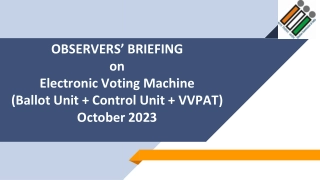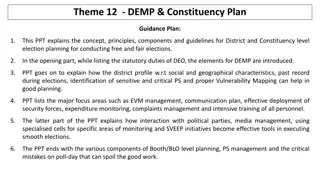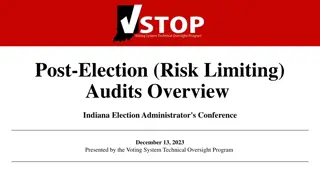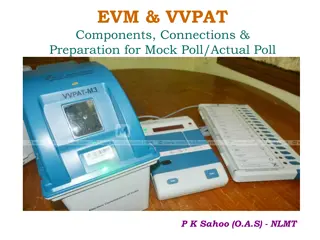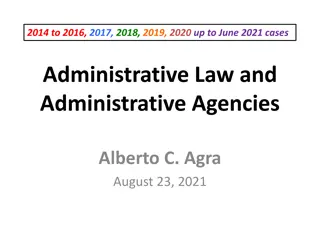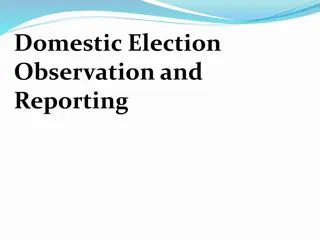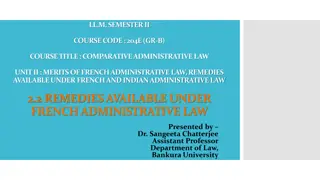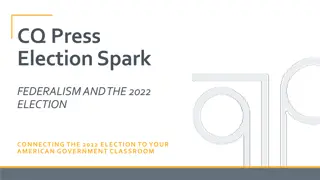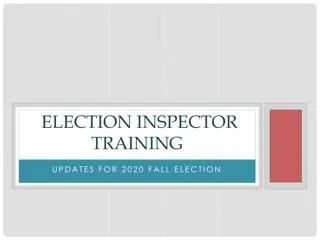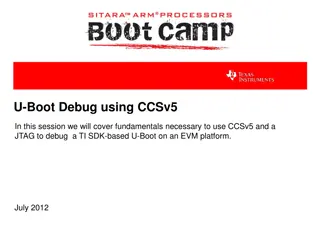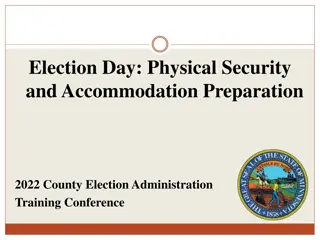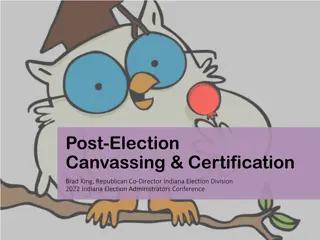EVM-VVPAT Administrative Procedures for Election Management
This document outlines the standard operating procedures (SoP) for Electronic Voting Machines (EVMs) and Voter Verifiable Paper Audit Trail (VVPAT) systems used in elections. It covers the components of EVMs, the process of voting, the roles of polling officers, and various sub-topics such as storage, first-level checking, randomization, and critical mistakes to avoid during the electoral process.
Download Presentation

Please find below an Image/Link to download the presentation.
The content on the website is provided AS IS for your information and personal use only. It may not be sold, licensed, or shared on other websites without obtaining consent from the author.If you encounter any issues during the download, it is possible that the publisher has removed the file from their server.
You are allowed to download the files provided on this website for personal or commercial use, subject to the condition that they are used lawfully. All files are the property of their respective owners.
The content on the website is provided AS IS for your information and personal use only. It may not be sold, licensed, or shared on other websites without obtaining consent from the author.
E N D
Presentation Transcript
Administrative SoP on EVM-VVPAT By Madhusudan Gupta, Secretary, ECI (8810689142) O.P. Sahani, Under Secretary, ECI
1. What is EVM? (Ballot Unit + Control Unit + VVPAT) 2
EVM (Ballot Unit + Control Unit + VVPAT) EVM consists of Ballot Unit, Control Unit and VVPAT Polling Officer presses the Ballot Button of Control Unit which enable the voter to cast his vote using Ballot Unit When a voter presses a button against the candidate of his choice in Ballot Unit, red light glow against candidate of his choice in Ballot Unit. A paper slip showing the serial no, name and the symbol of the candidate of his choice is generated and visible for about 7 seconds transparent window of VVPAT Control Unit Ballot Unit VVPAT through 3
Control Unit CONTROL UNIT- enables the Ballot Unit to accept vote from the voter and stores the vote cast . 4
Ballot Unit BALLOT UNIT- the voter can franchise his/her pressing a button against the candidate of his/her choice vote by 5
VVPAT VVPAT- allows the voters to verify that their votes are cast as intended. 6
POLLING STATION LAYOUT Polling Agents Voting Compartment Polling Officer s BU & VVPAT Presiding Officer with CU Voter 7
Sub-topics 1. Storage 2. First Level Checking 3. Randomizations 4. Commissioning/Preparation 5. Dispersal Day 6. Poll Day 7. Example of Critical Mistakes
1. Storage (1/9) A. Non-election Period: After Election Petition till start of FLC B. Election Period: FLC to Election Petition Period C. Petition Period: After Counting of Votes to confirmation of Election Petition Period
1. Storage (2/9) A. Non-election Period: Storage Place: Treasury/District HQs/Tehsil HQs Physical Aspects of WH: o Only 1 entry/exist point o Double lock system o Installation of Main Switch outside WH/Strong Room o No other material to be stored Custody of keys: o All keys of Lock-1 with DEO and all keys of Lock-2 with Dy.DEO (District HQs) o All keys of Lock-1 with SDM and all keys of Lock-2 with Tehsildar (Outside District HQs) o Deposition of keys in Treasury o Handling of keys to be a part of CTC (Certificate of Transfer Charge)
1. Storage (3/9) A. Non-election Period: Security: o 1/2 Section Armed Security o CCTV/Fire Alarm o Fire extinguisher both inside and outside Inspection by DEO: o Monthly o Quarterly (April, July, October & January)
1. Storage (4/9) B. Election Period (Strong Room): i. FLC to 1st Randomization ii. After 1st Randomization to dispersal iii. Poll Day to before Counting Day iv. Counting Day
1. Storage (5/9) B. Election Period: i. FLC to 1st Randomization o Custody of DEO o Strong Room with Double Lock System o All keys of Lock-1 with DEO and all keys of Lock-2 with Dy.DEO o 1 Section Armed Security o CCTV o Open for taking out Awareness/Training units (10%) and after 1st Randomization in presence of political parties (National & State Recognised) under videography
1. Storage (6/9) B. Election Period: ii. After 1st Randomization to dispersal o Custody of RO o Double Lock System o All keys of Lock-1 with RO and all keys of Lock-2 with ARO o 1 Section Armed Security o CCTV o Open only after commissioning/preparation and on dispersal day in presence of candidates/ their agents under videography 2nd Randomization for
1. Storage (7/9) B. Election Period: iii. Poll Day to before Counting Day o Custody of RO o Double Lock System o All keys of Lock-1 with RO and all keys of Lock-2 with ARO o CCTV o 1 Platoon Armed Security (2 tier Security) o No one allow to enter inner tier o Daily visit of RO/ARO/DEO/SP o Candidates/their agents are allowed to watch security
1. Storage (8/9) B. Election Period: iv. Counting Day o 1 Platoon Armed Security o 3 tier Security on Counting Day: Inner- CPAF, Middle-SAP, Outer-DAP o CCTV o Opening/Closing of Strong Room in presence of candidates/ their agents under videography
1. Storage (9/9) C. Petition Period: o Custody of DEO o 1 Platoon Security o CCTV
2. First Level Checking (1/4) Schedule of FLC and intimation to political parties Arrangements for FLC Work to be done during FLC Supervision of FLC Marking of FLC Status on EVM Management System (EMS)
2. First Level Checking (2/4) Schedule of FLC and intimation to political parties o CEO/DEO to prepare schedule o Intimation of political parties at the district HQs with intimation to State HQs Arrangements for FLC o Spacious, well-lit, dust-free hall o FLC area to be barricaded and sanitized by police o Entry of hall through Door Frame Metal Detector o Entry on production of ID Card issued by DEO o Webcasting of FLC process o Arrangement of manpower
2. First Level Checking (3/4) Work to be done during FLC o FLC only by authorised engineers of BEL/ECIL o FLC Process Cleaning of machine Visual Inspection Full functionality checks: 1 vote to each candidate for EVM, 6 votes to each candidate button for VVPAT. In 1% testing by connecting 4 BUs. Conduct of Mock Poll: Randomly Selected (5% EVMs and VVPATs)- 1200 votes in 1%, 1000 votes in 2% and 500 votes in 2% and verification o Opening of plastic cabinet of EVM and sealing of CU Cabinet with Pink Paper Seal Supervision of FLC o Under close supervision of DEO o FLC Supervisor appointed by DEO o CEO/DEO to monitor through web cast
2. First Level Checking (4/4) Disposal of VVPAT slips generated during FLC on daily basis Marking on FLC Status on EMS o DEO to provide 2 mobiles o FLC OK to be scanned by election official o FLC Rejected to be scanned by BEL/ECIL engineer
3. Randomizations Randomizations in EMS only First Randomization o After FLC at DEO Level o In presence of political parties o To allocate AC-wise Second Randomization o Before commissioning/preparation at RO Level o In presence of candidates/their agents o To allocate PS-wise
4. Commissioning/Preparation In presence of candidates/their representatives Under videography Work Done o VVPAT: Symbol Loading/Power Pack/Paper Roll/Sealing of Paper Roll Compartment o Ballot Unit: Ballot Paper/Thumb-wheel setting/Masking/Sealing with Pink Paper Seal and Address Tags o Control Unit: Candidate Setting/sealing of Candidate Set and Power Pack Sections with Address Tags 1 vote to each candidate button 1000 votes in randomly selected 5% EVMs and VVPATs and verification Replacement of particular BU, CU and VVPAT in case of non-functional Disposal of VVPAT slips generated during commissioning on daily basis Pasting of Reserve stickers on reserve units
5. Dispersal Day In presence of candidates/their representatives Checking of seals, buttons, switch, ballot etc to ensure correctness and pertaining to particular PS Not to test VVPAT Replacement of particular BU, CU and VVPAT in case of non-functional
6. Poll Day (1/2) Start of Mock Poll before 90 minutes Atleast 50 votes and 1 vote to each candidate/NOTA Sealing of CU and VVPAT after mock poll Pressing of CLOSE BUTTON after completion of Poll Sealing of BU/CU/VVPAT in respective carrying case Replacement Protocol o Respective Unit during Mock Poll o Entire Set (BU+CU+VVPAT) in case of Non-functional of BU or CU and VVPAT only in case of Non-functional of VVPAT o Handling of critical situations- no beep sound, no paper cutting, 49MA etc.
6. Poll Day (2/2) EVM management on Poll Day o Category A: Polled Units (with PO) o Category B: Polled Defective Units (with PO) o Category C: Un-polled Defective Units (with SO) o Category D: Reserved Units (with SO) Strong Room: Category A and Category B (Collected at Collection Centre) Repair Room: Category C (Collected at separate Collection Centre) Separate Strong Room: Category D (Collected at separate Collection Centre) All movement to be GPS tracked Proper security with all category of units
7. Examples of Critical Mistakes (1/3) First Level Checking of EVMs and VVPATs Non-Updation of FLC-OK or FLC-Reject status in EMS through Mobile-App on day to day basis. FLC of VVPATs without using Dummy Ballot Paper on BU. Non-Uploading of 16 candidates (including NOTA) Dummy Symbols in the 1% VVPATs used for testing with 4-BUs having 64 dummy symbols (including NOTA) Irregularity on use of Dummy Symbols Commissioning of EVMs and VVPATs Non-checking of candidate symbols uploaded in VVPAT during commissioning. In case of M3 EVMs, M3 VVPATs and all BUs must be connected at the time of commissioning of the EVMs otherwise EVM will not accept a VVPAT or BU at a later stage.
7. Examples of Critical Mistakes (2/3) Transportation of VVPATs Lock paper roll when transporting the VVPAT from one place to another Dispersal Do not switch on the VVPAT in broad daylight at the time of dispersal as the VVPAT may go into error mode. Mock-Poll on Poll Day Not pressing the CLOSE button of CU after mock-poll. Not matching the mock-poll result of the CU with the VVPAT Paper Slips. Not removing the mock-poll paper slips from VVPAT Non-deletion of mock-poll data from the Control Unit. When setting up the EVMs and VVPATs in the polling station, the VVPAT should be positioned so as to avoid direct light from falling on it. Do not position the VVPAT near an open window or directly under a bulb or halogen lamp.
7. Examples of Critical Mistakes (3/3) During Poll Conducting mock poll, in case of replacement of VVPAT only as Mock poll is not required to be conducted in case of only VVPAT being replaced. In case of non-functioning of CU or BU replacing only CU or BU. In such case both BU and CU alongwith VVPAT shall be replaced. Non-pressing of CLOSE Button after completion of Poll. Damaging any seal of BU/CU/VVPAT. General Do not repeatedly switch ON and OFF the VVPAT as it will deplete the battery as well as paper roll. Switch OFF the CU when connecting or disconnecting the EVMs/VVPATs and do not pull the cable for disconnecting. In case of M3 VVPAT, there is no VSDU and VVPAT status will be displayed on the CU Display Panel.
Counting Arrangements & Instructions For Counting on July 2021
Arrangements at Counting Hall EVMs LAY OUT OF COUNTING HALL EVMs LAY OUT OF COUNTING HALL Spacious halls for social distancing Adequate lighting with Generator backup Separate entry and exit 7 Counting Tables in each Counting Hall (or as approved by the Commission) VCB in only 1 Counting Hall (RO present) per AC/AS Barricades using transparent material/wire-mesh Videography/cctv of counting process in general Large whiteboard having pre-written candidates name/round numbers. Black Board C.S C.S 14 C.A 7 C.A C.S C.S 6 13 C.A C.A Counting Agents of candidates Counting Agents of candidates C.S C.S C.A 12 C.A 5 C.S C.S C.A C.A 4 11 C.S C.S C.A C.A 3 10 C.S C.S C.A C.A 2 9 C.S C.S 8 C.A C.A 1 R.O for AC/ ARO for PC Candidates/ Agents Clerks to assist C.S=Counting Supervisor; C.A. = Counting Assistant
To ensure infrastructure and security arrangements at counting centres Three tier cordoning security Outer cordon: by Local police Middle cordon: at the gate of counting premises by SAP Inner cordon: at door of Counting Hall by CAPF Smooth flow of EVMs/VVPATs from strong room to counting hall with CCTV coverage with no blind spots and without crisscrossing paths with another strong room/counting hall. Opening of strong room in presence of candidates/their agents, RO and Observer under videography
Media Centre SETTING UP MEDIA CENTRE Separate Room for Media Centre Appoint one senior officer from the Public Relation Department for Media Centre Allow media persons in small batches and for short duration only to visit Counting Hall Prohibition of mobile phone and other communication equipment by media person in Counting Hall. Allow mobile phones or Communication equipments from Media Centre
General Provide account of PB to contesting candidates on daily basis Provide latest account of PB to Observer on previous day of counting Provide latest account of PB to Observer on counting day also Take PB count first at 8.00 AM Not more than 500 PBs in one Table An ARO for each Table. Candidates are allowed to depute counting agents for each PB Table Where victory marginis less than the number of rejected PB as invalid, all the rejected PB shall be mandatorily re-verified by RO and Observer before declaration of result under videography
General At 8.30 AM start counting of votes from EVMs Examination of seals of CU and Form 17 C to ensure CU was actually used at that particular polling station and shown to candidates/counting agents Note down result displayed on CU in Part-II of FORM-17C carefully and ensure signing by Counting Agents and Counting Supervisors Photocopy of round-wise tabulation signed by RO and Observer provides to candidates/their agents RO shall be responsible for any inaccuracy/discrepancy in Form 20. EVM counting go on irrespective of the stage of Postal Ballot counting. Once EVM counting is completed, VVPAT slips counting start as per prescribed procedure
Challenges in EVM Counts Serial number of seals mentioned in Form 17C does not match Unique ID of CU mentioned in Form 17C does not match Seal of the CU or its carrying case is damaged/broken Use of multiple sets of EVMs and VVPATs in a particular PS Low Power or No Power in the CU thereby non retrieval of polled data No display or Partial display (segment issue) in CU Non-closure of CLOSE button by PO on poll day Non-compliance of mock poll procedure cases Total votes polled in CU do not match with total polled votes entered in Form-17C
Encore Counting Application
Infra Requirement Dedicated Computer, Printer, Scanner Redundant IT system for each RO. Dedicated 8MBPS leased line for counting centre with fixed IP address for each computer. Backup 8MBPS leased line with Internet connectivity from diff. service provider. Generator Power Backup Online UPS with sufficient backup and surge protection Disabling all USB ports and drives except Printers Installation of Updated antivirus with current definition Microsoft Office licensed version and patched up DIO to be responsible for network architecture and operations
Process- A day before counting day Step 2 Step 3 Step 1 Account set up Table Assignment Round Set up Create additional RO- Computer Assistant for data entry of votes Assign tables to users for data entry of EVM votes Rounds = Total Polling Stations/ Total Tables setup in counting centre Activate account and set password and PIN 42
Process- On counting day Step 1 Table wise EVM Votes entry for each Round Step 2 Round Declaration Step 3 Postal Ballot Votes entry Step 4 Results Declaration Table 1 Table 2 . . . . . . Table N Round 1 Round 2 . . . . . . Round N Enter Postal Ballot Votes & Finalise Finalise EVM votes and Postal Votes entry & Declare Results after verification of complete data 43
Counting of VVPAT Slips
ARRANGEMENTS FOR COUNTING OF VVPAT PAPER SLIPS Dimension of VCB: 6ft x 6ft x 8ft VCB shall be enclosed in a wire-mesh just like a Bank Cashier Cabin, so that no VVPAT paper slip can be accessed by any un authorised person. Installation of CCTV at ceiling One of the Counting Tables inside the Counting Hall (RO Hall) shall be earmarked by the Returning Officer as VVPAT Counting Booth (VCB) for Counting of VVPAT Paper Slips.
VVPAT COUNTING BOOTH (VCB) PIGEON HOLE CONTAINER
SEQUENCE OF VVPAT PAPER SLIPS COUNTING Counting of VVPAT slips of polling station (s) due to non-display of result on CU. Counting of VVPAT slips of polling station (s) due to non-compliance of mock poll. Note: For Assembly Constituency-in such case, VVPAT slips count is NOT required, if winning margin is more than the total votes in that particular polling station(s) Counting of VVPAT slips under Rule 56D of the Conduct of Elections Rules 1961 Mandatory verification of VVAPT slips of randomly selected 05 polling stations per AC/each AS of PC. NOTE: 1. Count the VVPAT slips one by one not simultaneously 2. In case more than 1 VVPAT used in a PS, both will come in VCB, but counting of slips shall be done one by one.
APPLICATION FOR VVPAT PAPER SLIPS COUNTING After announcement of result sheet entries, any candidate, their election agent or their counting agents may apply in writing (Under Rule 56 of the Conduct of Elections Rules 1961) to the RO to count the printed VVPAT paper slips in any or all polling stations. If such application is made, the RO shall pass a speaking order on whether the VVPAT paper slips should be counted. If the RO decides to allow the counting of the VVPAT paper slips of any or all polling stations, such decision of the RO must be recorded in writing along with the reasons thereof. The RO shall give due consideration to the following: 1. Whether the total number of votes polled in that polling station is greater or lesser than the margin of votes between winning candidate and candidate making the application 2. Whether EVM had a problem and was replaced at that polling station during poll 3. Whether there was any complaint about VVPAT not printing or complaints by any voter under Rule 49MA in that polling station during the poll.
MANDATORY VERIFICATION OF VVPAT PAPER SLIPS Mandatory verification of VVPAT paper slips of randomly selected 05 (five) polling station shall be conducted in all General and Bye Elections to the House of the People and State Legislative Assemblies, in addition to the provisions of Rule 56D of the Conduct of Elections Rules, 1961, after the completion of the last round of counting of votes recorded in the EVMs, as under: In case of General and Bye elections to State Legislative Assemblies, verification of VVPAT paper slips of randomly selected 05 (five) polling stations per Assembly Constituency. In case of General and Bye elections to the House of the People, verification of VVPAT paper slips of randomly selected 05 (five) polling stations of each Assembly Segment of the Parliamentary Constituency concerned.
RANDOM SELECTION OF PS FOR PAPER COUNTS. Written intimation regarding draw of lots by RO to Candidates/Election agents well in advance Draw of lots must be conducted after completion of CU counts Procedure for the conduct of draw of lots: White colour paper cards of postcard shall be used for conducting the draw of lots Total number of such paper cards should be equal to total number of polling stations in the AC/AS The paper cards shall have pre-printed AC/AS number, AC/AS name and date of poll on the top, and the polling station number in the centre. Each digit of the polling station number shall be atleast 1 x1 (1 inch by 1 inch) size and printed in black. The paper cards to be used for draw of lots should be four folded in such a way that polling station number is not visible. Each paper cards shall be shown to the candidates/their agents before folding and dropping in the container. The paper cards shall be shown in the big container and must be shaken before picking up 01 (one) slip by the Returning Officer.



